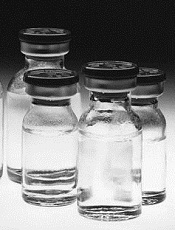
Credit: Bill Branson
The antitumor agent bleomycin can treat a range of cancers, but its disease-fighting properties have been poorly understood.
Now, a pair of researchers have characterized bleomycin’s ability to cut through double-stranded DNA in cancerous cells.
The duo believe their research could help inform efforts to fine-tune the drug, improving its cancer-killing properties and limiting toxicity to healthy cells.
The research appears in the Journal of the American Chemical Society.
Bleomycin is part of a family of structurally related antibiotics produced by the bacterium Streptomyces verticillus. Three potent versions of the drug—labeled A2, A5, and B2—are the primary forms in clinical use against cancers.
Previous research has shown that bleomycin can cause death in aberrant cells by migrating to the cell nucleus, binding with DNA, and subsequently causing breaks in the DNA sequence. Following a binding event, a molecule of bleomycin can effectively slice through one or both strands of DNA.
Cleavage of DNA is believed to be the primary mechanism by which bleomycin kills cancer cells, particularly through double-strand cleavages, which are more challenging for the cellular machinery to repair.
“There are several mechanisms for repairing both single-strand and double-strand breaks in DNA, but double-strand breaks are a more potent form of DNA lesion,” explained study author Basab Roy, a graduate student at Arizona State University in Tempe.
For this study, Roy and Sidney Hecht, PhD, used bleomycin A5, which has similar DNA binding and cleaving properties as bleomycin A2 and B2.
Previous research revealed that bleomycin binds with highly specific regions of the DNA strand, typically G-C sites, where a guanosine base pairs with a cytidine. The strength of this binding is closely associated with the degree of double-strand DNA cleavage.
From a pool of random DNA sequences, the researchers selected a library of 10 hairpin DNAs, based on their strong binding affinity for bleomycin A5. Hairpin DNAs are looped structures that form when a segment of a DNA strand base-pairs with another portion of the same strand. These hairpin DNAs were used to investigate double-strand cleavage.
Each of the 10 DNA samples underwent double-strand cleavage at more than one site. All of the observed cleavage sites were found within or in close proximity to an 8-base-pair-variable region.
Examination of the 10 DNA samples exposed to bleomycin revealed a total of 31 double-strand cleavage sites. Earlier research had described the form of double-strand DNA cleavage bleomycin induced at 14 of these sites. But the remaining 17 cases of double-stranded cleavage occurred through a different mechanism, described for the first time by Roy and Dr Hecht.
The pair used iron (FeII) as a cofactor for bleomycin in the binding events, and they observed 2 types of bleomycin binding and cleavage activity.
In the first, bleomycin and its iron cofactor (Fe.BLM) bind with hairpin DNA at a primary site. Typically, this is a site with a particular sequence: 5´-G-Py-B-3´. (Here, 5´ refers to one end of the DNA hairpin, G refers to the base guanosine, Py refers to a pyrimidinic base—either cytidine or thymidine, B refers to any nucleobase, and 3´ refers to the other DNA end.)
The result of this binding is the abstraction of a hydrogen atom at the primary site. Two results are possible following the primary binding event, one causing a single-strand break in the primary site and the other, failing to produce full cleavage of the strand, producing instead a site lacking either a purine or pyrimidine base. This is known as an AP site.
In the first case—where bleomycin achieves single strand cleavage—the bleomycin molecule can then become reactivated, once more abstracting a hydrogen atom from the opposing DNA strand.
The opposite strand can again follow 1 of 2 pathways, (a) full cleavage of the opposing strand, yielding a double-strand cleavage or (b) formation of an AP site. The researchers noted that this AP site can lead to strand cleavage through the opposing DNA strand with the addition of a mild base like n-butylamine.
The results of this study emphasize the correlation between the strength of bleomycin binding to DNA and the frequency of double-strand cleavage. Of the 10 sample hairpin DNAs, the 2 most tightly bound to bleomycin each showed 5 double-strand cleavages, whereas the least tightly bound samples exhibited just 2 double-strand cleavages.
This suggests a plausible mechanism for DNA cleavage by bleomycin that may lead to tumor cell killing, as well as identifying the most common sequences involved in DNA site binding and subsequent strand breakage.
Roy noted, however, that more research is needed to elucidate the biochemical causes of tight binding by bleomycin. Furthermore, bleomycin’s specificity for cancer cells remains enigmatic.
“Cancer is still a black hole,” Roy said. “We’re trying to make this particular molecule better. There is still so much to learn.”

